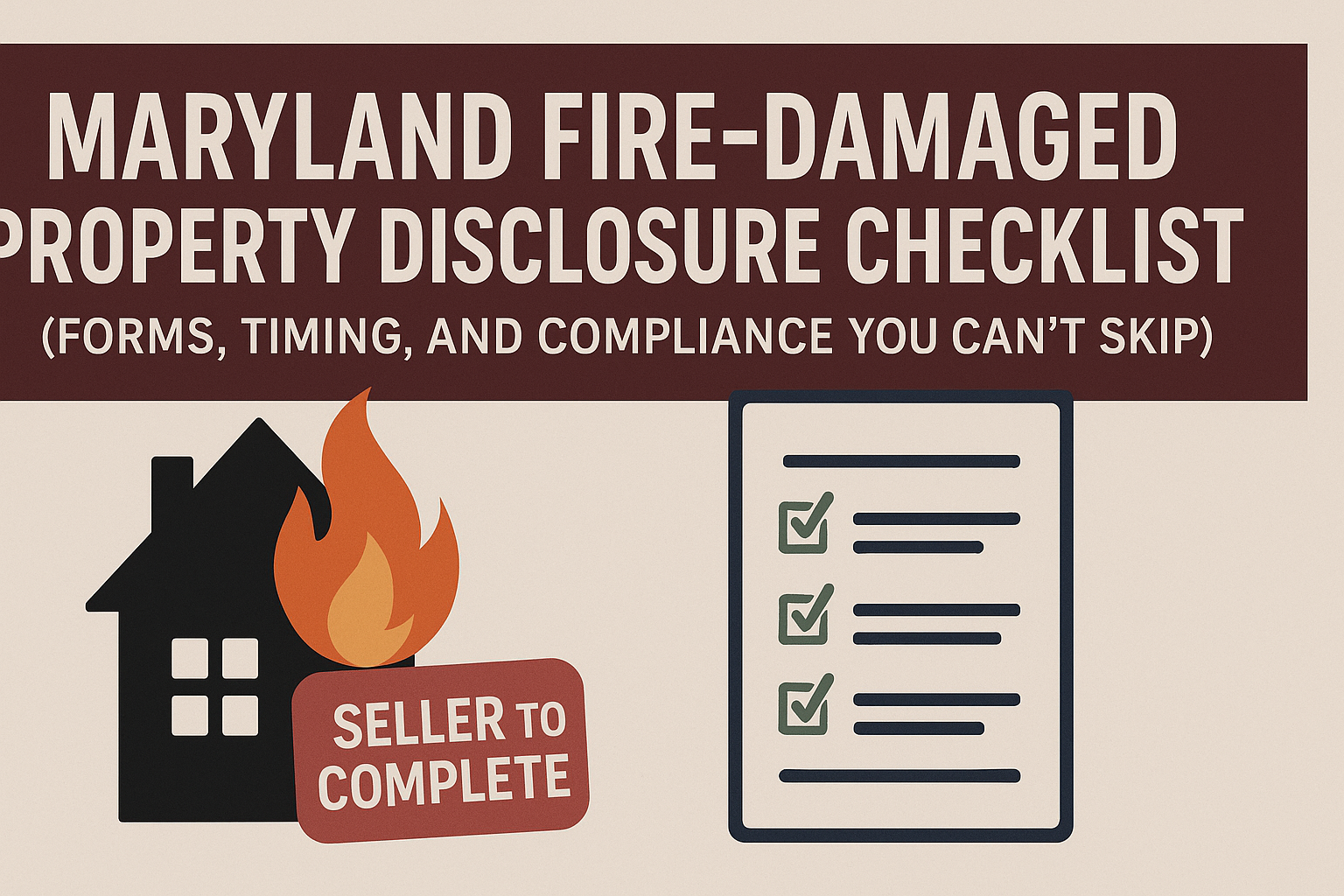
You’re looking for a practical Maryland disclosure checklist tailored to a fire‑damaged home—not another generic article that dodges your real risk. You want to know exactly what to disclose, which forms Maryland requires, what “as‑is” actually means under state law, and how to package documentation so buyers feel confident enough to move forward quickly (ideally for cash). That’s what this guide delivers: a step‑by‑step disclosure flow, county‑aware tips, and links to the official Maryland statute and forms plus federal safety materials—so you can stay compliant and protect your net.
1) Maryland Seller Disclosure Law for Fire‑Damaged Homes (Real Property §10‑702 Explained)
Start with the law. Maryland’s Residential Property Disclosure/Disclaimer regime is codified in Maryland Real Property §10‑702 seller disclosure law. You must give buyers either a disclosure (defects you know about) or a disclaimer (you won’t make representations)—but you still must disclose any known latent defects (material defects not reasonably observable that pose a threat to health or safety). For fire‑damaged homes, that typically includes electrical and structural impacts, smoke/soot residues, and any system failures derived from the incident.
Use the official form. The State requires the specific Maryland Residential Property Disclosure & Disclaimer Statement. The Maryland Real Estate Commission forms page points you to the current version; many brokerages also mirror it. Delivering the form on or before contract signing avoids rescission windows and ensures the buyer signs an acknowledgment of receipt attached to the contract—language spelled out in §10‑702. For consumer‑friendly framing of what must be provided, see the Notice to Buyer and Seller – MD Property Condition Disclosure Law.
What “as‑is” really means. Even with a disclaimer and an as‑is contract, you must disclose known latent defects. Legal teaching materials used by Maryland title professionals emphasize that the latent‑defect duty survives “as‑is.” For a plain‑language summary that tracks the statute, see this training handout from the Maryland Land Title Association: Maryland RESIDENTIAL PROPERTY DISCLOSURE / DISCLAIMER overview.
Internal link location: At the end of this section, place a sentence like: “If you’re deciding between repairing or selling as‑is, review our full guide: How to Sell a Fire‑Damaged House in Maryland.”
2) Fire‑Specific Material Facts to Disclose (Smoke, Structural, Electrical, Systems)
Disclose fire‑related impacts early and in writing. Use the State form to note date and origin of the fire (if known), rooms/areas impacted, and specific systems touched: electrical, HVAC, plumbing, roof framing, attic/insulation, windows/doors, and interior finishes. If firefighters used water inside, note any drying, dehumidification, or mold prevention steps. Buyers and appraisers take persistent smoke odors seriously; include what you did about soot/odor remediation.
Smoke alarm compliance is material. Maryland requires home smoke alarms to meet updated specs (including 10‑year sealed battery units in many contexts). A consumer‑facing flyer from Maryland REALTORS summarizes obligations and notes that information about alarms is treated as material facts to be disclosed: Smoke Alarm law flyer (Maryland REALTORS). Some counties publish their own guides; for example, Anne Arundel’s brochure explains replacement intervals and requirements: Maryland’s updated smoke alarm law (brochure).
Attach evidence buyers trust. Include the fire report (if available), contractor/adjuster estimates, permit approvals, and completion certificates for any repairs. If a county inspector has issued a damage inspection report or you’ve pulled a Restore/Repair permit (see Section 4), include those PDFs in your disclosure packet.
3) Lead‑Paint & Environmental Disclosures (Pre‑1978 Homes, Renovation & Cleanup)
Lead matters in fire repairs. If your Maryland home was built before 1978, state and federal law require lead‑hazard disclosures. The People’s Law Library explains seller/owner obligations and points to state law cross‑references: Lead Paint Law: Information for Owners and Sellers and Lead Paint Law for Renters & Buyers (with Md. Code Env. §6‑824). In practice, that means disclosing any known lead hazards and whether remediation is planned before the sale.
Provide the federal pamphlet. Federal rules require sellers of pre‑1978 homes to deliver the EPA/HUD/CPSC pamphlet Protect Your Family From Lead in Your Home to buyers. You or your agent should obtain a signed receipt acknowledging delivery. Many Maryland brokerages also use a state‑branded Lead Poisoning Prevention Program Disclosure; the Maryland REALTORS form gives standardized language about responsibilities after settlement: Maryland Lead Poisoning Prevention Program Disclosure (PDF).
Use lead‑safe work practices. If you repair before selling, contractors must follow EPA RRP (Renovation, Repair & Painting) rules when disturbing painted surfaces in pre‑1978 homes. Compliance protects health and keeps your transaction on track if a buyer’s inspector flags unsafe cleanup. The federal overview is here: EPA Lead Renovation, Repair and Painting (RRP) program.
4) County Documents That Help Your Disclosure Packet (Permits & Inspection Reports)
County paperwork builds buyer trust. When a house has had a fire, buyers want government‑issued proof that repairs are permitted and inspected (or a clear picture of what’s still pending). If you’re in Montgomery County, the Department of Permitting Services explains the Restore/Repair permit process and offers a homeowner permits overview so owner‑sellers know what requires a permit. In Prince George’s County, disaster cases can use Emergency Repair Authorization to stabilize hazards quickly, and owners can request a Damaged Property Inspection & Report (inspectors aim to contact you within five business days after a request). In Baltimore City, the Permit Handbook (PDF) and Permits portal lay out when you need a permit and what drawings/inspections are expected.
How to use these in your packet:
- Include permit numbers, inspection approvals, and final sign‑offs for any completed work.
- If work is in progress, attach the permit card and schedule showing upcoming inspections.
- If you’re selling as‑is, include any county damage inspection reports and a simple summary of known conditions.
Providing official documents cuts renegotiation risk and shortens the buyer’s diligence period—helping you keep momentum to closing.
5) Delivery, Signatures & Timing: Avoiding Rescission and Delays
Timing matters. Under Maryland Real Property §10‑702 seller disclosure law, you deliver the Disclosure/Disclaimer Statement on or before entering into the contract. The buyer signs an acknowledgment of receipt that is included in or attached to the contract. If buyers don’t receive the form until after signing, rescission rights can apply for a limited period. Avoid the confusion: send the form with your offer packet and keep the counters clean.
Bundle everything. Your disclosure packet should include:
- The State Disclosure/Disclaimer (official PDF form).
- Lead disclosures (and the EPA lead pamphlet) for pre‑1978 homes.
- Smoke alarm compliance notes using Maryland REALTORS’ summary flyer (or your local fire marshal’s guidance).
- County permits/inspections (Montgomery/PG/Baltimore examples linked above).
- Fire report, adjuster/contractor estimates, and photos.
Keep acknowledgments tight. Put every receipt/acknowledgment (disclosure form, EPA pamphlet) in one PDF, signed by the buyer(s) and date‑stamped, then reference it in the contract’s addenda list. That way, underwriters and title don’t slow you down later tracking paperwork.
Internal link location: Near the end of this section, add: “If timing and paperwork feel heavy, consider an as‑is cash sale—compare speed and net in How to Sell a Fire‑Damaged House in Maryland.”
6) “As‑Is” Sales, Latent Defects & Negotiation Strategy (Read This Before You List)
As‑is is not a shield. Maryland’s framework lets you disclaim representations, but the latent‑defect duty remains. If a fire‑related hazard could endanger occupants—compromised framing, unsafe wiring, soot‑contaminated HVAC, non‑functional smoke alarms—you disclose it even on an as‑is sale. The Maryland RESIDENTIAL PROPERTY DISCLOSURE / DISCLAIMER overview used by title professionals spells this out clearly. If you fail to disclose, you risk re‑trades, post‑closing disputes, or worse.
Use documentation as leverage. When you’re selling as‑is to a cash buyer, the right packet narrows their risk discount: attach the county’s damage inspection report (PG example above), any permit cards, and a list of stabilization actions (board‑up, utility safety checks, soot cleanup). If you’ve replaced alarms, note that you followed Maryland’s smoke alarm updates with current devices (see the Maryland REALTORS smoke alarm flyer). The more you shore up safety and paperwork, the less a buyer needs to discount for uncertainty.
If you intend to repair. Use county permit guidance (e.g., Montgomery County Restore/Repair) to outline your plan, and mention RRP compliance if pre‑1978 work will disturb paint (EPA RRP program). A credible plan gives financed buyers a path, but remember: it also brings inspections and time. Decide based on net‑after‑time.
7) Your Ready‑to‑Send Disclosure Packet (Template Language You Can Adapt)
Subject: Seller Disclosure Packet – 123 Main St, Anytown, MD 20XXX (Fire Event on 4/12/2025)
Hi [Buyer/Agent Name],
Attached please find the complete Maryland Residential Property Disclosure/Disclaimer Statement, signed and dated, along with the following documents to streamline your diligence:
- Fire Report (incident # and department contact)
- Contractor/Adjuster Estimates (dated; with scope and photos)
- County Permits & Inspections (permit #, inspection dates/outcomes)
- Lead‑Paint Disclosures (pre‑1978 property) and EPA pamphlet receipt: Protect Your Family From Lead in Your Home
- Smoke Alarm Compliance Notes (new units installed; see Maryland guidance: Smoke Alarm law flyer)
- Photos (before/after stabilization)
Please confirm receipt by signing the acknowledgment page in the disclosure packet so we can include it with the contract. If you have any questions about permits or inspections, the County resources linked above provide process details. We’re happy to accommodate a brief access window for your inspector within [X] days.
Best regards,
[Your Name]
8) Frequently Asked Questions (Maryland‑Specific)
Do I have to disclose the fire if everything was repaired?
Yes—if you know of defects or conditions related to the fire that are latent and could affect safety, you disclose. Use the official MD Disclosure/Disclaimer form and attach documentation.
Can I just sell as‑is and say nothing?
No. “As‑is” doesn’t waive the duty to disclose known latent defects under §10‑702. Package your disclosures properly and you’ll still keep momentum.
Do I have to give the federal lead pamphlet?
If the home is pre‑1978, yes—deliver Protect Your Family From Lead in Your Home and obtain a signed receipt.
What about smoke alarms—do buyers really care?
Yes. Compliance is a material fact and buyers/agents are trained to ask. See the Maryland REALTORS smoke alarm flyer and, where helpful, your local fire marshal’s guidance (e.g., updated smoke alarm law brochure).
If I deliver disclosures late, can the buyer cancel?
§10‑702 provides rescission rights when forms are delivered after contract. Avoid this: send your packet with offers and get acknowledgments signed and attached.
9) Final Take: Compliance as a Sales Tool (and When to Consider Cash)
Compliance sells. A complete, Maryland‑specific disclosure packet reduces buyer uncertainty, shortens diligence, and keeps appraisers neutral on property condition. If you’re repairing, it gives financed buyers a cleaner path. If you’re selling as‑is, it lowers the risk premium investors apply—improving your net‑after‑time even if your top‑line price is lower than retail.
Pick the path that fits your timeline. If your county permit path and inspections will take months—or your home is pre‑1978 and triggers RRP—sell as‑is to a vetted cash buyer and keep moving. If your scope is contained, you have strong comps, and your documentation is airtight, repair‑and‑list can reasonably capture retail. Either way, lead with transparency and keep every acknowledgment signed and attached to the contract.
Want the side‑by‑side of speed, certainty, and net proceeds? Read How to Sell a Fire‑Damaged House in Maryland.”
